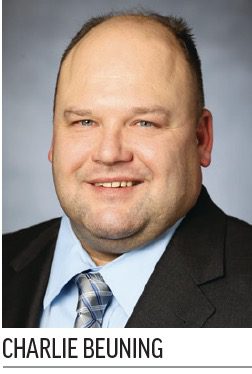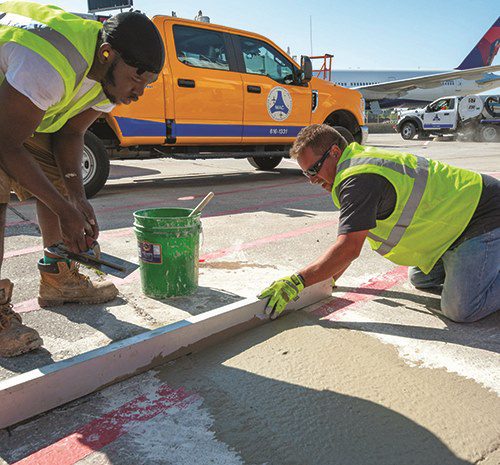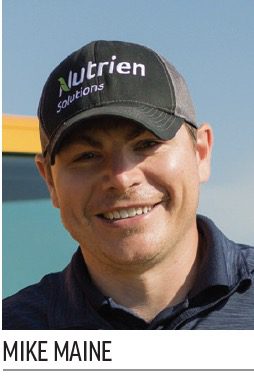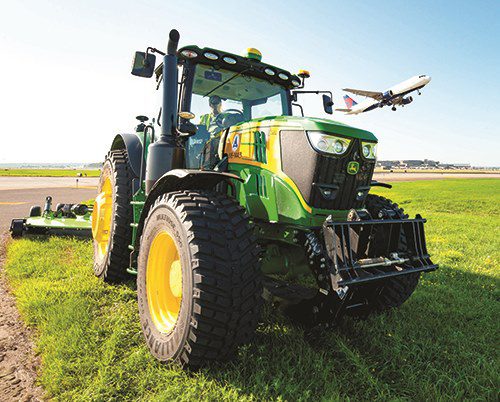The maintenance team at Minneapolis-St. Paul International Airport (MSP) is well-known for its expertise in snow removal. But after the snow stops flying, crews quickly turn their attention to a myriad of other duties. Much of the off-season work centers on landscape management to help deter wildlife on the airport’s 2,930-acre campus.
The maintenance team at Minneapolis-St. Paul International Airport (MSP) is well-known for its expertise in snow removal. But after the snow stops flying, crews quickly turn their attention to a myriad of other duties.
 Much of the off-season work centers on landscape management to help deter wildlife on the airport’s 2,930-acre campus. However, the roughly 90-person department also scours parking ramps, mends fences, maintains signage and repairs runways, roads, taxiways and aprons.
Much of the off-season work centers on landscape management to help deter wildlife on the airport’s 2,930-acre campus. However, the roughly 90-person department also scours parking ramps, mends fences, maintains signage and repairs runways, roads, taxiways and aprons.
Those assigned to the fleet maintenance team keep everything from weed whackers and backpack blowers to service vehicles and fire trucks running in tip-top shape. The 30-person group includes welders, mechanics, equipment-service workers, parts personnel and the like.
In short, maintenance employees aren’t sitting around waiting for the next snowstorm to blow in. “I’m amazed at all the work our employees do every day,” says Charlie Beuning, MSP’s field maintenance operations manager.
|
facts&figures Project: Landscape Management Location: Minneapolis-St. Paul Int’l Airport Consultant: Nutrien Solutions Funding: Airport revenue Mowing Equipment: Deere & Co., Exmark Manufacturing; Hagie Manufacturing Co.; Schulte Industries Ltd., The Toro Co. Herbicide Application Equipment: Kawasaki Motors Corp.; Polaris Inc.; Shindaiwa USA
Pavement Cleaning Equipment: Bobcat; Other Equipment: Stihl backpack blowers Program Benefits: Less time spent mowing & applying herbicides; less herbicides used & handled by employees; better wildlife deterrence; increased employee productivity; enhanced vegetation control; decreased fuel costs; less engine emissions |
The parking facilities alone are a handful to maintain. Currently, the airport has nine garages with 75 levels and close to 29,000 individual parking spaces. To enhance the longevity of the parking structures, crews power-wash every level of all ramps to remove oil, grease, salt and other harmful materials. It takes crews using specialized utility equipment six months to complete the job.
“It’s a very long process,” Beuning remarks.
Machines from Triverus Cleaning & Environmental Solutions capture spent water and cleaning chemicals so they don’t drain into stormwater sewers. Crews empty the collected waste mixture into sanitary sewers for treatment to make the process more eco-friendly.
The Beat Goes on
The airport also has a construction team that performs concrete and asphalt surface repairs on runways and roadways—a never-ending job thanks to Minnesota’s harsh weather. When such repairs are needed during winter, employees sometimes deploy powerful space heaters inside ice fishing tents to make pavement warm enough for patching.
Maintenance employees also periodically repaint 750,000 square feet of runway markings and 900,000 square feet of taxiway markings each year. They apply about 14,850 gallons of paint and 47 tons of reflective glass beads to keep airfield markings clear and visible for pilots.
“All that snow removal—plowing and brooming—wears away the lines and markings,” Beuning explains.
Then there are 20 miles of perimeter security fences to maintain and repair. Maintenance employees also empty more than 200 trash receptacles and blow clean six miles of sidewalks every day using Stihl backpack blowers. Street cleaning machines are regularly used on airport roadways, and smaller pavement cleaning machines help tidy other areas.

“We also have a team dedicated to taking care of all airfield and roadway signage,” adds Beuning. “You wouldn’t believe what happens to signs, with large semi-trucks and construction vehicles driving through here. We always have signs going down.”
Controlling Vegetation
Four years ago, MSP adopted a landscape management program developed by Nutrien Ag Solutions, a consulting division of global giant Nutrien Ltd. After using the program for several growing seasons, Beuning reports that the efficiency/productivity of ground crews is up and MSP’s use of herbicides is down.
By removing food sources of birds and other animals, the program also helps minimize the chances of wildlife strikes and enhances the airport’s compliance with FAA requirements for weed control. From a health and safety standpoint, employees are handling fewer chemicals and reducing engine emissions and fuel consumption, thanks to less frequent mowings and herbicide applications.
 While it’s simple to compare the amount of gas burned or landscaping chemicals applied, the financial savings associated with the program are more difficult to quantify. However Beuning notes that grounds crews now have more time for other tasks because they are spending less time applying herbicides and mowing the airport’s 1,000 acres of airfield turf. Bottom line: MSP is able to get more done with the same number of employees.
While it’s simple to compare the amount of gas burned or landscaping chemicals applied, the financial savings associated with the program are more difficult to quantify. However Beuning notes that grounds crews now have more time for other tasks because they are spending less time applying herbicides and mowing the airport’s 1,000 acres of airfield turf. Bottom line: MSP is able to get more done with the same number of employees.
“Landscape management absolutely tends to fly under the radar because it’s not as glamorous as, say, a new terminal or people mover,” says Mike Maine, project manager of vegetation management at Nutrien Solutions. “The importance of it often is overlooked.
“Nonetheless, vegetation control is an FAA requirement,” adds Maine, who has an urban forestry degree and a master’s in ecological restoration. “Every airport has to do it…and sometimes they need a partner that knows how to manage landscapes effectively and efficiently.”
Rethinking Herbicides
One of the biggest changes to MSP’s landscape management strategy is a significant reduction in the herbicide use. Previously, crews applied two different herbicides: one for killing weeds in turf areas and another for killing weeds in pavement cracks and crevasses, landscape beds, along fence lines and so forth.
Because the weeds invariably grew back, crews had to apply herbicides three to four times a year. Moreover, mixing and applying them are labor-intensive and time-consuming. In addition to 1,000 feet of airfield turf, the airport has 320 more acres of grass outside the airfield and 50 acres of landscaped beds, filled with shrubs, trees and flowers.
“Spraying herbicides could take weeks,” Beuning says, noting that crews use a combination of propelled spraying equipment and smaller backpack units. “Getting access to the airfield is difficult and requires a lot of coordination with airside operations.”
The solution? A herbicide created specifically for MSP that requires only one application per year. The custom blend is more expensive, but Beuning reports that the added cost is more than offset by less wear and tear on equipment, decreased fuel consumption and emissions, and increased productivity from ground crews.
“Labor costs are much higher than the cost of the herbicide,” Maine points out.
Increased Efficiency
Since the airport switched to a custom-blended herbicide, employees no longer need to mix multiple chemicals. Now, they add a half-gallon of the herbicide to a 50-gallon tank of water on a spraying machine. It is much more efficient than the old method, Maine stresses.
“Putting together the herbicide is a very simple process,” Beuning concurs. “And we only apply a half-gallon of herbicide mixture per acre, once a year, which reduces the amount of active herbicide ingredients in the environment.”
The custom-blended mix, which includes four to five different herbicides, targets unwelcome vegetation such as rogue grasses, broadleaf weeds and woody vines. It also contains a pre-emergent herbicide that prevents weeds from germinating, Maine explains.
Beuning has noticed that the benefits are cyclical: Grass grows better without weeds, and more vigorous, healthier grass can naturally deter weed growth.

“Nutrien also provided hands-on training that taught our crews to properly apply herbicides and to know what they were applying and why,” he adds. “That was great because we are leanly staffed, so it’s important for us to work smarter, not harder.”
Maine also showed employees how to calibrate equipment for optimal herbicide application and stressed the importance of wearing personal protective gear. “He coached them just like they were a sports team,” Beuning remarks.
Slowing Growth
Another key aspect of the program is every homeowner’s dream: applying a growth-retardant to turf areas so grass doesn’t grow as quickly. This is particularly useful in the airfield, where there’s never a good time to mow the grass, Beuning observes.
Maine explains that the treatment, known in the industry as plant growth regulation, stops grass from growing for four to six weeks, depending on rainfall.
In addition, the airport is starting to use a high-endophyte seed to grow a special variety of tall fescue that is both drought- and salt-tolerant. Better yet, the seed’s endophytes (symbiotic fungus that live inside plants) make the grass extremely distasteful to birds and other wildlife.
“Plant growth regulation and the custom-blended herbicides are the two main cornerstones of the program,” Maine states. “They’re the biggest timesavers and provide airports with the most bang for their buck.
“Think about how much turf there is at an airport,” he continues. “It creates a huge safety issue because wildlife is attracted to weeds and flowers and plants on the airfield. So if you eliminate those food sources, the birds and other wildlife are less likely to show up.
“In my industry, we jokingly refer to it as removing the fridge from the airfield.”

Easier-Going Mowing
Anyone who has pushed a manual lawnmower knows that grass with a lot of weeds is tougher to mow. The same is true for the airport’s riding equipment.
“You’re almost weed-whacking with the mower; so you have to go a lot slower,” Maine explains. “We can reduce the time it takes to mow turf by 50% just by reducing weeds, which become more fibrous after they get cut down and regrow.”
Ultimately, he boils it all down to maximizing airport employees’ time.
Crews at MSP use tractors towing “brush hogs” (mowing machines) to cut the large expanses of turf. Smaller zero-turn riding mowers are used in areas that require more maneuverability.
Overall, Beuning says it’s difficult to quantify exactly how much time and money Nutrien’s landscape management program is saving the airport. But he says there’s no doubt that it has reduced weed growth and the time required to mow and apply herbicides.
“This program has radically changed how we handle vegetation management,” Beuning reflects. “By increasing the efficiency of our grounds employees and including an employee education component, it has taken us to a whole new level.”



